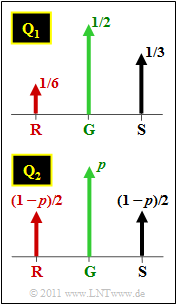Exercise 1.2: Entropy of Ternary Sources
The entropy of a discrete memoryless source with $M$ possible symbols is:
- $$H = \sum_{\mu = 1}^M p_{\mu} \cdot {\rm log}_2\hspace{0.1cm}\frac{1}{p_\mu}\hspace{0.05cm},\hspace{0.3cm} {\rm pseudo unit\hspace{-0.15cm}: \hspace{0.15cm}bit}\hspace{0.05cm}.$$
Here, the $p_\mu$ denote the occurrence probabilities of the individual symbols or events. In the present example, the events are denoted by $\rm R$(ed), $\rm G$(reen) and $\rm S$(chwarz) with "Schwarz" being the German word for "Black".
- For a binary source with the occurrence probabilities $p$ and $1-p$ this can be written:
- $$H = H_{\rm bin}(p) = p \cdot {\rm log}_2\hspace{0.1cm}\frac{1}{p}+ (1-p) \cdot {\rm log}_2\hspace{0.1cm}\frac{1}{1-p}\hspace{0.05cm},\hspace{0.3cm} \text{pseudo–unit: bit}\hspace{0.05cm}.$$
- The entropy of a multilevel source can often be expressed with this "binary entropy function" $H_{\rm bin}(p)$.
In this task, two ternary sources with the symbol probabilities according to the above graph are considered:
- source $\rm Q_1$ with $p_{\rm G }= 1/2$, $p_{\rm S }= 1/3$ and $p_{\rm R }= 1/6$,
- source $\rm Q_2$ with $p_{\rm G }= p$ and $p_{\rm S } = p_{\rm R } = (1-p)/2$.
- The ternary source $\rm Q_2$ can also be applied to "Roulette" when a player bets only on the squares $\rm R$(ed), $\rm S$(chwarz) and $\rm G$(reen) (the "zero"). This type of game is referred to as $\text{Roulette 1}$ in the question section.
- In contrast, $\text{Roulette 2}$ indicates that the player bets on single numbers $(0$, ... , $36)$.
Hint:
- The task belongs to the chapter Discrete Memoryless Sources.
Questions
Solution
- $$H \hspace{0.1cm} = \hspace{0.1cm} 1/2 \cdot {\rm log}_2\hspace{0.1cm}(2) +1/3 \cdot {\rm log}_2\hspace{0.1cm}(3) +1/6 \cdot {\rm log}_2\hspace{0.1cm}(6) =(1/2 + 1/6)\cdot {\rm log}_2\hspace{0.1cm}(2) + (1/3 + 1/6)\cdot {\rm log}_2\hspace{0.1cm}(3) \hspace{0.15cm}\underline {\approx 1.46 \, {\rm bit}} \hspace{0.05cm}.$$
(2) Proposed solution 2 is correct:
- The entropy depends only on the probabilities of occurrence.
- It does not matter which numerical values or physical quantities one assigns to the individual symbols.
- It is different with mean values or the ACF (auto correlation function) calculation. If only symbols are given, no moments can be calculated for them.
- Moreover, the mean values, auto-correlation, etc. depend on whether one agrees on the assignment bipolar $(-1, \hspace{0.10cm}0, \hspace{0.05cm}+1)$ or unipolar $(0, \hspace{0.05cm}1, \hspace{0.05cm}2)$ .
(3) The entropy of source $\rm Q_2$ can be expressed as follows:
- $$H \hspace{0.1cm} = \hspace{0.1cm} p \cdot {\rm log}_2\hspace{0.1cm}\frac {1}{p}+ 2 \cdot \frac{1-p}{2} \cdot {\rm log}_2\hspace{0.1cm}\frac {2}{1-p}= p \cdot {\rm log}_2\hspace{0.1cm}\frac {1}{p}+ (1-p) \cdot {\rm log}_2\hspace{0.1cm}\frac {1}{1-p} + (1-p)\cdot {\rm log}_2\hspace{0.1cm}(2)= H_{\rm bin}(p) + 1-p \hspace{0.05cm}.$$
- For $p = 0.5$ ⇒ $H_{\rm bin}(p) = 1$ , we get $\underline{H = 1.5\hspace{0.05cm}\rm bit}$.
(4) The maximum entropy of a memoryless source with symbol set size $M$ is obtained when all $M$ symbols are equally probable.
- For the special case $M=3$ it follows:
- $$p_{\rm R} + p_{\rm G} + p_{\rm S} = 1 \hspace{0.3cm} \Rightarrow \hspace{0.3cm} \underline {p = 1/3 \approx 0.333}\hspace{0.05cm}.$$
- Thus, using the result of sub-task (3) , we obtain the following entropy:
- $$H = H_{\rm bin}(1/3) + 1-1/3 = 1/3 \cdot {\rm log}_2\hspace{0.1cm}(3) + 2/3 \cdot {\rm log}_2\hspace{0.1cm}(3/2) + 2/3 $$
- $$\Rightarrow \hspace{0.3cm}H = 1/3 \cdot {\rm log}_2\hspace{0.1cm}(3) + 2/3 \cdot {\rm log}_2\hspace{0.1cm}(3) - 2/3 \cdot {\rm log}_2\hspace{0.1cm}(2)+ 2/3 = {\rm log}_2\hspace{0.1cm}(3) = {1.585 \, {\rm bit}} \hspace{0.05cm}.$$
(5) The source model $\text{Roulette 1}$ is information theoretically equal to the configuration $\rm Q_2$ with $p = 1/37$:
- $$p_{\rm G} = p = \frac{1}{37}\hspace{0.05cm},\hspace{0.2cm} p_{\rm R} = p_{\rm S} = \frac{1-p}{2} = \frac{18}{37} \hspace{0.05cm}.$$
- Thus, using the result of subtask (3), we obtain:
- $$H = H_{\rm bin}(1/37) + \frac{36}{37} = \frac{1}{37} \cdot {\rm log}_2\hspace{0.1cm}(37) + \frac{36}{37} \cdot {\rm log}_2\hspace{0.1cm}(37) - \frac{36}{37} \cdot {\rm log}_2\hspace{0.1cm}36 + \frac{36}{37} = {\rm log}_2\hspace{0.1cm}(37) + \frac{36}{37} \cdot ( 1- {\rm log}_2\hspace{0.1cm}(36)) = 5.209 - 4.057 \hspace{0.15cm} \underline { = 1.152 \, {\rm bit}} \hspace{0.05cm}.$$
(6) If we bet on single numbers in roulette ⇒ source model $\text{Roulette 2}$, all numbers from $0$ to $36$ are equally probable and we get:
- $$H = {\rm log}_2\hspace{0.1cm}(37) \hspace{0.15cm} \underline { = 5.209 \, {\rm bit}} \hspace{0.05cm}.$$
